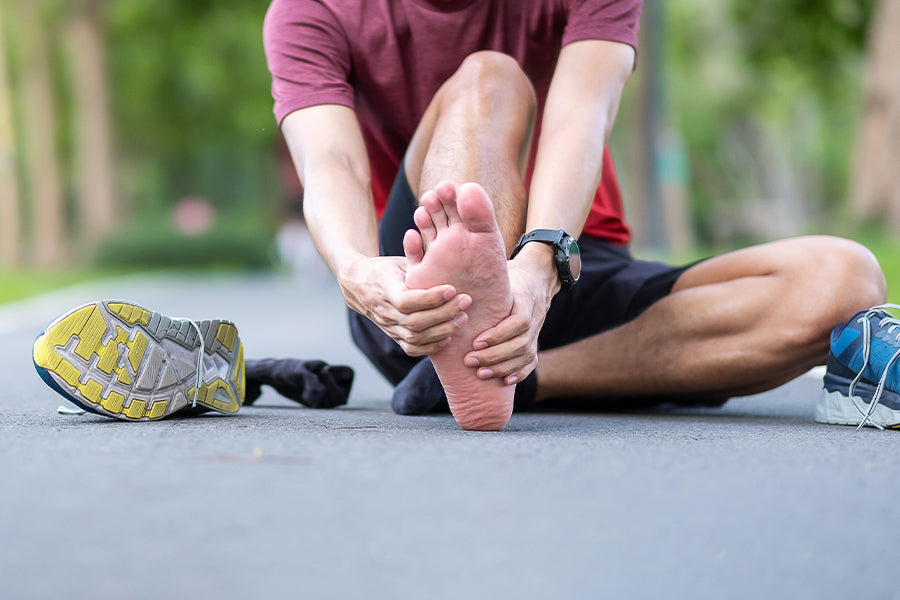Plantar fasciitis is a condition that can cause heel pain and discomfort. The plantar fascia is a band of tissue running along the bottom of the foot from the heel to the toes. When this tissue becomes inflamed or irritated, it can cause pain in the heel or arch of the foot.
However, with the proper treatment, you can manage plantar fasciitis and get back to normal activities with less pain. This article will give tips for running safely with plantar fasciitis.
Some of the common symptoms of plantar fasciitis include the following:
- Pain on the bottom of the heel.
- Pain that worsens with taking the first step in the morning.
- Pain that causes discomfort after prolonged walking, sitting, or lying down.
- Pain that prolongs for months.
- Swollen heels
- Decreased ankle range of motion and tightening in calf muscles
Cause of Plantar Fasciitis Pain
Different factors can cause plantar fasciitis pain. One of the most common causes is overuse. If you are a runner who regularly runs long distances, you may be more susceptible to developing plantar fasciitis. Other risk factors include:
- Having flat feet with low foot arches
- Obesity
- Having tight calf muscles and high arches
- Working out frequently on a hard floor.
- Working out without stretching your calves
- Standing for a prolonged time.
Running With Plantar Fasciitis: Is It Safe?
Running with plantar fasciitis is safe and can be done in moderation. However, it's important to remember that running — even if it's just walking — can exacerbate the symptoms of plantar fasciitis.
If you have plantar fasciitis, you should avoid jumping or sprinting, increasing the tension on your arch and further irritating your plantar fascia. The best way to run with plantar fasciitis is by using a heel pad or shoe insert to relieve pressure on your foot and give it some extra support.
You should also keep your strides short and quick instead of long and slow. This will reduce how much energy is transferred up through your legs and into your feet, which can help prevent further damage to your arch while also reducing pain and inflammation.
10 Tips for Runners With Plantar Fasciitis
Tweaking your lifestyle and following specific tips can help reduce pain for runners with plantar fasciitis.
1. Don't Wear Unsupportive Shoes
If you have flat feet with low foot arches, you're more likely to become a victim of plantar fasciitis due to too much strain on the foot arches, causing stress on the plantar fascia. This condition can develop chronic inflammation of the plantar fascia over time.
However, if you want to run without experiencing much pain, you must wear the right yet comfortable shoes. Wearing shoes with supportive foot arches will help you maintain proper alignment of the joints, your feet, ankle, and connective tissue muscles.
2. Warm Up First Before Setting Out for Run
Warm-up is a must to do before any exercise. For victims of plantar fasciitis, warm-up before running can improve their blood circulation, and decrease joint stiffness and muscle tightness, thus reducing strain on the feet.
To warm up your body before exercise, you can perform different exercises that help activate your muscles, such as heel raises, ankle circles, squats, lunges, and leg swings.
Related Article: Why Warm-Up Exercises are Important for HIIT Workouts | DMoose
3. Perform Cross-Training Workouts
Plantar Fasciitis is a painful injury that can sideline runners, so it's essential to know the best way to treat it. The good news: Cross-training workouts can help mitigate the effects of Plantar Fasciitis — and even prevent it in some cases.
You can start with a walk or do lightweight training, or you can do more intense training and involve using weights or machines that simulate running. Furthermore, it helps keep your muscles strong and flexible so they don't become strained from constantly pounding them while running.
4. Do Plantar Fasciitis Stretches Daily
Plantar fasciitis is a painful condition that occurs due to incorrect foot positioning. To prevent this from happening, perform stretches daily. You should begin with a warm-up and walk to increase blood flow in your feet.
Afterward, you can do a set of calf raises or heel raises. You can also perform other stretches that require you to use your toes and your heels. You can use a foot and leg stretcher to help you relieve the plantar fasciitis pain.
Related Article: 25 Most Effective Stretches to Do Before Exercising
5. Massage Your Feet Carefully
Massaging your feet correctly can help reduce pressure and relieve pain. All you need to do is massage in a clockwise motion while lying down on your back. Start at the toes and work up toward the top of your foot.
Use an upward motion, starting with your toes and moving toward your ankle bones until you reach below where your calf meets your thigh muscle. This will make you feel good. Don't forget about those calves — they deserve some soothing massage too.
6. Avoid Running on Uneven Surfaces
Avoid running on uneven or hard surfaces. It requires more force from your feet and ankle muscles to stabilize your joints. Also, it damages the plantar fascia, making it hard for you to run.
You can visit the nearest jogging tracks to prevent you from running on rough surfaces and experiencing foot injury.
7. Rub Ice Daily
Ice application on affected areas helps runners with plantar fasciitis decrease pain, inflammation, and swelling. This simple and easy tip uses a bag filled with crushed ice wrapped in a towel. The runner sits on the massage table, puts one foot on the table, and places the bag of ice on their arch pain point.
After 20 to 30 minutes, they remove the bag, massage it into the spot for another 10 seconds, then remove it again. The runner should repeat this process three times daily as it is very effective.
8. Take Rest
Running regularly without allowing your body to rest can damage the arches of your feet. Resting between and after the run will help your body recover and prevent it from developing plantar fasciitis.
9. Address Any Foot Pain
Several types of foot pain may decrease your ability to put pressure on your feet and cause trouble when running or walking.
However, it is better to consult your physical therapist or podiatrist to diagnose the underlying cause of your foot pain and receive appropriate treatment.
10. Go for Kinesiology Taping
Applying two pieces of Kinesiology tape to your foot and ankle may help you achieve better foot alignment, which may lessen pain and support your arches as you run or walk. You can apply the first piece of the tape near the heel from the bottom of the foot.
You can also apply the second piece at the outside edge of the bottom of the foot and push it horizontally over the arch. The first piece of the tape will provide a stretch and keep the foot positioned up at you, while the second piece of tape will support the arch of your foot.
When to See a Doctor
See a medical expert if the pain persists for more than two weeks. To alleviate symptoms, your doctor may recommend treatments, including orthotics, foot taping, cortisone injections, night splints, and anti-inflammatory drugs.
If there is any severe case, your doctor might prescribe physical or shock-wave therapy. However, if the situation doesn’t improve, your doctor may turn to platelet-rich plasma (PRP), in which they draw blood from your arm, spin it down, remove the platelets, and inject them into the fascia.
For those who continue to experience symptoms even after treatment, their doctor might advise them to go for surgery. That is mainly the last option, and before opting for surgery, your doctor would need to consider your overall medical condition.
FAQs
1. How do runners deal with plantar fasciitis?
Mostly, they put their feet in an ice bucket. Then, massage their feet with golf balls. It helps relieve the pain caused due to plantar fasciitis.
2. How can I fix plantar fasciitis fast?
Use a cloth-covered ice pack to relieve discomfort. Stretch the arch. Simple home exercises can stretch the plantar fascia, Achilles tendon, and calves.
3. What causes plantar fasciitis on the bottom of the foot?
Plantar fasciitis affects the bottom of the foot, most commonly causing pain in the center and the inner side of the heel. It is caused by injury to the plantar fascia, a sturdy band of tissue that extends from the heel under the foot's arch to the base of the toes.
Conclusion
Plantar fasciitis is an inflammation of the plantar fascia (bottom of the foot) that can worsen due to running, walking, or standing for too long. However, practicing simple home treatments such as ice massage, resting, wearing comfortable shoes, applying kinesiology tape, etc., can help alleviate the symptoms. If the pain persists, consult a doctor.
Reading List
11 Incredible Tips to Speed Up Muscle Recovery | DMoose
3 Expert Muscle Building Tips Every Beginner Should Know | DMoose
Are You Ready to Get Fit? - Training Workout for Beginners | DMoose
Find Out How You Can Alleviate Pain Naturally and Effectively – DMoose
Article Sources
- Goff, J. D., & Crawford, R. (2011). Diagnosis and treatment of plantar fasciitis. American Family Physician, 84(6), 676–682. https://pubmed.ncbi.nlm.nih.gov/21916393/
- Management of plantar fasciitis in the outpatient setting | SMJ. (n.d.). Www.smj.org.sg. Retrieved August 30, 2022, from http://www.smj.org.sg/article/management-plantar-fasciitis-outpatient-setting








